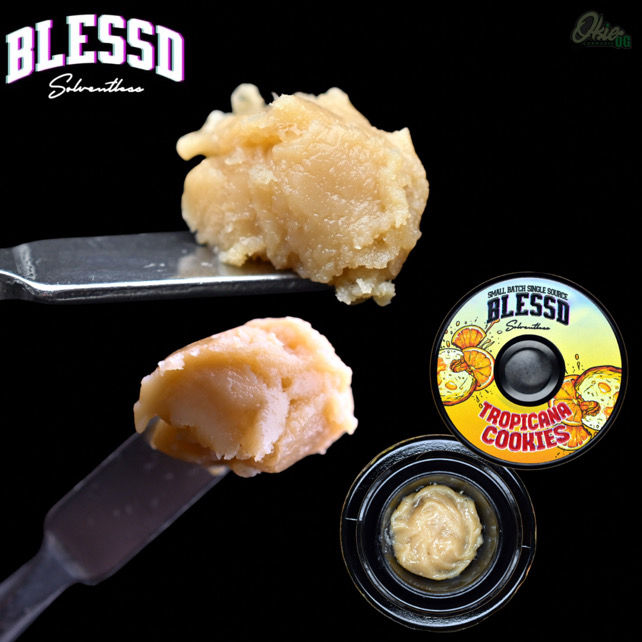How We Press: Behind the Scenes of Solventless Rosin
- blessdsolventless
- Sep 9
- 4 min read
When you’re hunting for solventless rosin in Oklahoma, you’re not just looking for something to dab—you’re looking for a craft experience. With solventless, the process is the product.
Every wash, every sieve, every press is what defines whether the end result is mids… or true fire. At Blessd Solventless, we see rosin pressing in Oklahoma not as just extraction, but as craft hashmaking rooted in patience, precision, and pride.

The Wash: Ice, Water, and Patience in Oklahoma Craft Hashmaking
Every jar of Blessd rosin starts life in the wash room. Fresh frozen cannabis, harvested at its prime, meets ice and pure water. Through gentle agitation, trichome heads—the resin glands rich in cannabinoids and terpenes (Livingston et al., 2020; Happyana et al., 2013)—are separated from plant material.
This first step in the solventless rosin process is about respect. Push too hard, and you pull in leaf and contamination. Go too soft, and you leave resin behind.
The goal is clean, sandy hash that reflects Oklahoma’s craft hashmaking culture.
Separation & Drying: Protecting Resin Integrity in Solventless Processing
Once washed, resin heads are filtered through micron screens to separate different grades. Full melt quality hash—high on the connoisseur’s list—is captured from these prime fractions (Bernstein et al., 2019).
But raw, wet hash is fragile. Left in uncontrolled conditions, oxidation, loss of volatile terpenes, and even microbial growth can occur (Calvi et al., 2018).
Terpenes like limonene and myrcene are easily lost under environmental stress (Russo, 2011), which is why Blessd employs freeze drying. This method uses sublimation to preserve terpenes and maintain the stability of hash across the solventless rosin process (Fraser et al., 2006; Jin et al., 2021).
By protecting terpene integrity in Oklahoma’s climate, we ensure only the cleanest resin hits the press.
The Press: Rosin Pressing Oklahoma Flower Into Gold
Here’s where culture and technique collide. The dried hash is sandwiched in parchment and subject to nothing but heat and pressure. Out flows rosin—bright, glossy, pure.
But not every press is created equal. Press too hot, and terpenes volatilize or degrade (Fischedick, 2017). Press too long, and cannabinoids like THC convert or break down (Citti et al., 2018). That’s why Blessd practices low‑temp pressing that prioritizes flavor over yield.
This is the rosin pressing Oklahoma connoisseurs wait for: full flavor, loud aroma, and uncut integrity. It’s the definition of craft hashmaking in concentrate form.
Small Batch Solventless: Why Blessd Chooses Craft Over Scale
Blessd doesn’t chase mass production or industrial efficiency. We chase small‑batch fire. Each cultivar is hand‑washed, carefully dried, and pressed on its own—never blended away into bulk runs.
Science backs up the small‑batch ethos. Research shows cannabis chemotype and terpene expression vary widely by cultivar and harvest conditions (Berman et al., 2018). By committing to a craft hashmaking philosophy, Blessd highlights that unique fingerprint in every Oklahoma wash.
Oklahoma Roots: Local Craft, Solventless Community
Blessd Solventless is Oklahoma‑born and proud of it. Our flower is grown, washed, dried, and pressed right here, feeding back into the state’s cannabis ecosystem.
Part of rosin pressing in Oklahoma is education. That’s why we open up the solventless rosin process through our Strain Library, cultivar spotlights, and FAQ. And when you need jars in hand, our trusted Retailers connect Oklahoma patients and consumers with truly small‑batch craft.
This is who we are: Oklahoma roots, connoisseur focus, solventless expertise.
Conclusion: Fire In, Fire Out — The Blessd Solventless Process
Look inside any Blessd jar of rosin, and you’ll see the story: carefully hand‑washed trichomes, freeze‑dried stability, low‑temp pressing, and Oklahoma‑rooted craft.
This is solventless as it’s meant to be—the solventless rosin process shaped by Oklahoma hashmakers.
Want to taste true craft hashmaking in Oklahoma? Explore our Strain Library or pick up jars at one of our Retailers.
Works Cited
Berman, P., Futoran, K., Lewitus, G. M., Mukha, D., Benami, M., Shlomi, T., & Meiri, D. (2018). Metabolomic analysis of Cannabis reveals cultivar‑specific profiles of secondary metabolites. Scientific Reports, 8(1), 6466.
Bernstein, N., Gorelick, J., & Koch, S. (2019). Interplay between chemistry and morphology in Cannabis sativa. Industrial Crops and Products, 129, 185‑194.
Calvi, L., Pentimalli, D., Panseri, S., et al. (2018). Comprehensive quality evaluation of medical Cannabis sativa L. inflorescence and oil: Chemical‑profile, contaminants, and toxicity. Frontiers in Pharmacology, 9, 841.
Citti, C., Pacchetti, B., Vandelli, M. A., Forni, F., & Cannazza, G. (2018). Analysis of cannabinoids in commercial hemp seed oil and decarboxylation kinetics studies of cannabidiolic acid (CBDA). Journal of Pharmaceutical and Biomedical Analysis, 149, 532–540.
Fischedick, J. (2017). Cannabis sativa: Interdisciplinary challenges and perspectives of analysis. Phytochemistry Reviews, 16, 525–538.
Fraser, M. C., et al. (2006). Freeze-drying of biologicals and pharmaceuticals: Principles and practice. Process Biochemistry, 41(9), 1828–1831.
Happyana, N., Agnolet, S., Muntendam, R., van Dam, A., Schneider, B., & Kayser, O. (2013). Analysis of cannabinoids in laser‑microdissected trichomes of medicinal Cannabis sativa using LCMS. Phytochemistry, 87, 51–59.
Jin, D., Dai, K., Xie, Z., & Chen, J. (2021). Biological and chemical stability of terpenes in Cannabis: Implications for high‑quality cultivation and processing. Frontiers in Plant Science, 12, 623454.
Livingston, S. J., Quilichini, T. D., Booth, J. K., Wong, D. C. J., Rensing, K. H., Laflamme‑Yonkman, J., ... & Page, J. E. (2020). Cannabis glandular trichomes alter morphology and metabolite content during flower maturation. The Plant Journal, 101(1), 37‑56.
Russo, E. B. (2011). Taming THC: Potential cannabis synergy and phytocannabinoid‑terpenoid entourage effects. British Journal of Pharmacology, 163(7), 1344‑1364.
Disclaimer: For use only by licensed medical marijuana patients. Please consume responsibly.





Comments